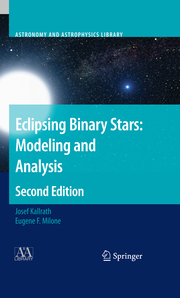Detailansicht
Eclipsing Binary Stars: Modeling and Analysis
Astronomy and Astrophysics Library
ISBN/EAN: 9781461429289
Umbreit-Nr.: 1506081
Sprache:
Englisch
Umfang: xxix, 420 S., 88 s/w Illustr., 420 p. 88 illus.
Format in cm:
Einband:
kartoniertes Buch
Erschienen am 25.02.2012
Auflage: 2/2009
- Zusatztext
- InhaltsangabeI Introduction.- The Database and Methods of Data Acquisition.- II Modeling and Analysis.- A General Approach to Modeling Eclipsing Binaries.- Determination of Eclipsing Binary Parameters.- Advanced Topics and Techniques.- III Light Curve Programs and Software Packages.- Light Curve Models and Software.- TheWilson–Devinney Program: Extensions and Applications.- Light Curve Software with Graphical User Interface and Visualization.- The Structure of Light Curve Programs and the Outlook for the Future.
- Kurztext
- Eclipsing Binary Stars focuses on the mathematical formulation of astrophysical models for the light curves of eclipsing binaries stars, and on the algorithms for evaluating and exploiting such models. Since information gained from binary systems provides much of what we know of the masses, luminosities, and radii of stars, such modeling is acquiring increasing importance in studies of stellar structure and evolution. As in other areas of science, the computer revolution has given many astronomers tools that previously only specialists could use; anyone with access to a set of data can now expect to be able to model it. This book will provide astronomers, both amateurs and professionals, with a guide for specifying an astrophysical model for a set of observations selecting an algorithm to determine the parameters of the model estimating the errors of the parameters Eclipsing Binary Stars is written for readers familiar with basic calculus and linear algebra; appendices cover mathematical details on such matters as optimization, coordinate systems, and specific models. This 2nd edition includes new physics in light curve models and distance fitting and implications on T1. Other improvements include, new features in the WD program, new applications in astronomy and astrophysics, new literature cases, Milone's papers and new software developments in the eclipsing binary community.
